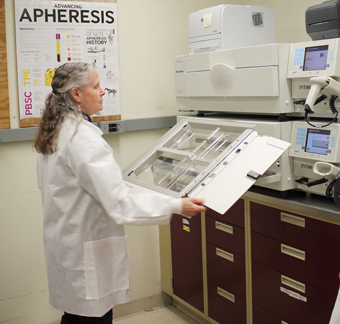Department of Transfusion Medicine improves safety of platelet transfusions


On Jan. 14, 2016, the Clinical Center Department of Transfusion Medicine (DTM) prepared the first pathogen reduced apheresis platelets at NIH and transfused them to a patient in the Intensive Care Unit. The CC became the first hospital in the U.S. to collect, prepare and transfuse pathogen reduced apheresis platelets.
Approved by the U.S. Food and Drug Administration in December 2014, the INTERCEPT Blood System for Platelets is used to inactivate a broad spectrum of viruses, bacteria and parasites as well as contaminating donor T-cells, a type of white blood cell, in platelet components. Blood components are very safe and are tested for various pathogens like HIV and the hepatitis B and C viruses. The INTERCEPT system may inactivate other microorganisms, such as the Zika virus, parasites and bacteria that can be difficult to detect.
The process uses amotosalen HCl (a light-activated compound) and ultraviolet (UVA) illumination to photochemically treat platelet components. This treatment procedure also inactivates donor T-cells to lower the risk of transfusion-associated graft-versus-host disease, eliminating the need to expose the platelets to radiation previously performed for the same purpose.
The DTM INTERCEPT implementation team has been working since March 2015 to bring pathogen reduced apheresis platelets to CC patients. This has been a true team effort, touching almost every section within the department. Apheresis platelets are collected at DTM's satellite facility on Fishers Lane in Rockville, part of the Blood Services Section; primary production steps are performed in the Laboratory Services Section; and platelets are counted in the Cell Processing Section for quality control purposes. Others involved included DTM's Quality Assurance group and IT Support staff.
"Not only have we implemented the INTERCEPT pathogen reduction system, but we've simultaneously introduced the use of Platelet Additive Solution (PAS) as part of the collection process," said Dr. Bill Ward, deputy chief of DTM. PAS is a buffered salt solution that replaces approximately 65% of the plasma in the apheresis platelet product. PAS products have recently been approved for use in the U.S. Research suggests that PAS may reduce certain types of transfusion reactions that may be seen in some patients, and improve platelet quality.
In 2015 alone, more than 3,500 apheresis platelet transfusions were administered to over 300 CC patients. The majority of apheresis platelet transfusions are to treat patients undergoing cancer therapy or organ and tissue transplants. The implementation of the pathogen reduction system and the collection of apheresis platelets in PAS further improve the safety of platelet transfusions for patients.